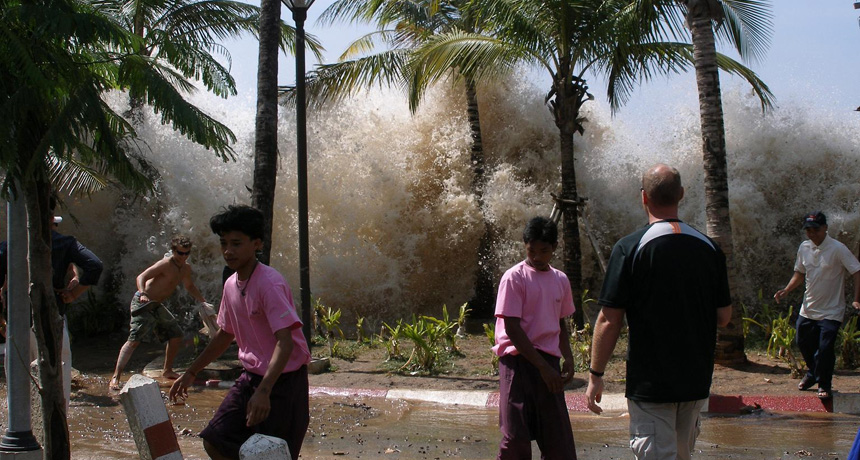Digging a trench to stop a tsunami
Boyd Kane of South Africa built a wave tank to see how to stop huge waves

A tsunami in Thailand in 2004. ISEF finalist Boyd Kane wanted to see if digging underwater trenches could stop the damage from these huge waves.
David Rydevik/Wikimedia Commons
LOS ANGELES – Earthquakes, volcanoes and other massive movements deep within the Earth disturb everything living above them. When they occur underneath oceans, their movements can produce gigantic waves called tsunamis. These waves, which can be 10 meters (32 feet) high or more, come racing into shore with little warning, causing death and destruction to people living near the coast. Boyd Kane, 16, wanted to see if they could be stopped. The sophomore at Diocesan College in Cape Town, South Africa, built his own wave tank from scratch to show that a trench on the seafloor might be enough to turn a tsunami into a harmless wave.
The teen presented his findings at the 62nd annual International Science and Engineering Fair. Created by Society for Science & the Public and sponsored by Intel, ISEF brings together high school students from all over the world to present their science projects. (SSP also publishes Science News for Students and this blog).
Boyd hypothesized that a trench in the seafloor might help take the energy out of big waves as they come toward the shore. “The basic concept is, if you were to dig a trench underwater in the path of a tsunami, the effect would be that the tsunami would come along and it would fall into the trench, and it would lose all of its energy,” he explains.
To test how wide such a trench would have to be to absorb a huge wave, Boyd built a wave tank. The tank was about two meters (6.6 feet) long and made of wood on three sides with a clear wall so he could observe the waves. Boyd used pulleys with weights attached to them to raise one end of his “seafloor.” The rising floor created a wave that was proportional to the amount of weight he used to raise the floor. At the other end of his tank, Boyd set up blocks to simulate a trench, anywhere from 5 to 110 centimeters wide (1.9 to 43.25 inches).
To find out how his trench held up against the tsunami, Boyd measured how high the wave was when it hit the opposite end of his wave tank. An effective trench would reduce the height of the wave. Kane was able to show that a trench about 70 centimeters (27.5 inches) wide could reduce the height of his experimental tsunami by up to 80 percent.
Of course, it’s one thing to simulate a trench by arranging wooden blocks in a wave tank, and quite another to dig one miles long and hundreds of meters wide on the seafloor. Kane needs to do more tests (and get a bigger wave tank), but he hopes that his trench could save many lives. “It wouldn’t be easy to implement,” he says, “but then you don’t have to cover the entire coastline. You could try selected spots such as harbors or large cities.” Who knows, someday people might be digging a larger version of his trench to stop huge waves.
Follow Eureka! Lab on Twitter
Power Words
earthquake A sudden and sometimes violent shaking of the ground, sometimes causing great destruction, as a result of movements within Earth’s crust or of volcanic action.
tsunami One or many long, high sea waves caused by an earthquake, submarine landslide or other disturbance.







